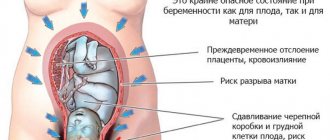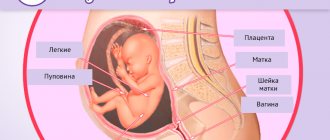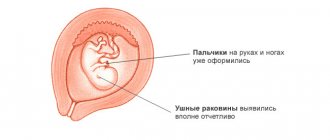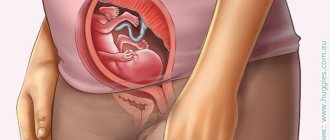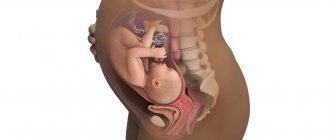Development of the baby at this stage
The second trimester is marked by a decrease in risks in fetal development. The baby is well established in the uterine cavity, the vital organs are formed. He is growing by leaps and bounds, accumulating weight. A baby at 14 weeks is the size of a small peach. He still has quite a bit of space in the uterus; he can easily and repeatedly change his position in it. In response to the baby’s movements, the uterus may become slightly toned, which the mother will certainly feel.
| Development parameters | Average normal values (at this time) |
| Fetal weight | ~ 35 – 40 g |
| Fetal size (distance from crown to rump) | ~ 12 – 14 cm |
| Length gain per week | 3 – 5 cm |
What happens to the fetal body:
- The face of the unborn baby continues to take shape. The bridge of the nose is drawn, and during an ultrasound examination you can see the cheeks and ears. The eyes are covered with eyelids and are no longer as wide apart as before;
- lanugo appears - germinal fluff. Lanugo performs a protective function by retaining a waxy substance (secret) secreted by the fetal body. Later in the mother's womb, the lanugo will be replaced by thicker hairs - fluff. A hint of vegetation appears on the baby's head;
- The fetal thyroid gland has matured enough to begin producing hormones. In male babies, the prostate appears; in girls, the ovaries descend from the abdominal region to the pelvic area;
- the child inside the womb reacts to substances dissolved in the amniotic fluid - in response to sweets, maximum swallowing movements can be noted. But the baby “doesn’t like” sour and bitter things and practically does not make swallowing movements if the liquid has such a taste;
- the baby is already producing urine and releasing it in small quantities into the amniotic fluid.
External changes during the 14th week of pregnancy
External signs of an “interesting situation” are already beginning to appear, but very little and this is not always noticeable to others. The belly at the 14th week of pregnancy is more clearly visible in those women who are not pregnant for the first time. The belly takes on a more noticeable shape if a woman lies on her back.
Starting from the fourteenth week, the expectant mother should give preference to spacious clothes, putting aside tight-fitting wardrobe items until better times. To avoid pinching the uterus and causing discomfort to the baby, you should purchase maternity clothing with inserts for the growing belly.
In the abdominal region, a dark vertical stripe may appear from the navel to the pubis. It does not occur in all pregnant women and disappears after the birth of the child. Also, severe itching may appear on the skin of the abdomen as a result of its stretching due to the growing uterus. To avoid stretch marks, which often remain for life, you need to start using various oils and emulsions against stretch marks from the 10th week.
You can also find out what external changes await you at 15 weeks of pregnancy. In addition, what symptoms and sensations accompany this week, how the baby develops during this period and much more. All the necessary information is in this article.

Changes in the body of the expectant mother
Toxicosis is no longer a problem, and the pregnant woman feels good and energetic. It is at this stage that a woman begins to fully realize her pregnancy. My belly is growing and my uterus is now the size of a large grapefruit. Pigment spots and freckles may appear, which will disappear after childbirth.
At fourteen weeks, the desire for hunger is acutely felt - you want to eat both day and night. Perhaps there is a craving for certain foods. This is how the body signals which minerals and substances it lacks.
| Parameters of a pregnant woman | Indicators for this period |
| Weight gain at current stage of pregnancy | 2 – 2.5 kg |
| HCG level in blood | 27300 – 233000 IU/ml |
| Norm of progesterone in the first trimester | 71.50 – 303.2 nmol/l |
What does the belly look like?

At fourteen weeks, a pregnant woman’s belly is already noticeable to others. A photo of the belly at this stage will already show the coveted roundness in comparison with previous weeks. A tummy that protrudes strongly forward can indicate a woman’s narrow or flat pelvis and weak abs. A round and “wide” belly often indicates excess amniotic fluid and a multiple pregnancy. Therefore, the shape of the abdomen is no less important for the obstetrician-gynecologist than the size and shape of the pelvis.
How does a woman feel during this period of bearing a child?
- There is frequent urination. The enlarging uterus puts pressure on the kidneys, ureters and bladder, causing frequent urge.
- Cramps in the calf muscles, back pain and itching in the abdominal area due to stretching of the skin may be bothersome.
- A pregnant woman may periodically experience heartburn. It is often accompanied by increased salivation, chest discomfort, and coughing. Heartburn is especially expected at the end of the first trimester (13th week of pregnancy). The reason for this is often increased intra-abdominal pressure due to the growth of the uterus and increasing pressure on the stomach.
- The discharge may become heavier than it was before. This is due to increased blood supply to the pelvic vessels. There is no reason to worry if test results indicate normal vaginal microflora.
- The drowsiness inherent in the first trimester subsides. The level of estrogen hormones gradually increases and their ratio with progesterone levels out, so sleep becomes more restful.
- Sometimes nasal congestion and runny nose not associated with a cold appear, as the increased amount of estrogen causes swelling of the mucous membrane of the respiratory tract and increases the secretion of mucus.
Frequently asked questions on the forums
1:
V.: 14 weeks, they diagnosed uterine tone, told me to treat myself at home, and prescribed suppositories. Is it very dangerous? Maybe you need to go to the hospital and not at home?
A.: Tone is especially dangerous in the 1st trimester; in the second, the threat of miscarriage is significantly reduced. Very often, the reason for the increased tone of the uterus is precisely the worries and worries of the pregnant woman, so you need to drive away bad thoughts and get more rest. Indeed, many people treat tone at home. Unfortunately, at one stage or another during pregnancy, almost every woman is faced with this diagnosis. In itself it is not scary. You should worry when there is bloody discharge or sharp, fairly strong cramping pain in the lower abdomen. If such symptoms are present, hospitalization is necessary.
2:
Q: Is it possible to sleep on your back?
A: From the beginning of the second trimester, doctors recommend that pregnant women get used to sleeping on their side. In the supine position, the growing uterus and the gaining weight of the fetus put pressure on the spine. At week 14, as a rule, the tummy is still small, and the mother can still allow herself to sleep on her back or stomach, but it is better to give up this habit now and try to fall asleep on her side.
3:
Q: Why does the lower back hurt at 4 months of pregnancy?
A: Your lower back may hurt at this stage if you have not yet switched from heels to flat shoes. Also, at 14-15 weeks of pregnancy, lower back pain may occur due to a shift in the center of gravity. At this stage, the uterus completely extends into the abdominal cavity, and some pressure begins to be exerted on the lower back. After a couple of weeks the pain should go away. If the pain is acute, then you need to consult a doctor.
Fetal movements at 14 weeks of pregnancy
The expectant mother in the 2nd trimester listens with trepidation to her inner sensations. Feeling your baby’s “answer” from the inside is so exciting. When will the little one make itself known with the first light, weightless tremors?
- The first fetal movements occur in the womb during the 7th-8th obstetric week of pregnancy. Its movements are still spontaneous, representing muscle contractions in response to nerve impulses.
- The fetus begins to actively move in the uterus from the 10th week, bumping into its walls and changing its trajectory. The toddler is still too small (weighing about 5 g), so his kicks are not yet felt by his mother.
- The unborn baby is growing up, and the pregnant woman feels his movements. The woman’s feelings at this moment cannot be expressed in words! Rare mothers note the beginning of movements at 14-16 weeks - in most cases these are cases of repeated pregnancy.
- Noticeable movements can also be noticed after the mother eats something sweet. It’s simple to explain: after eating, the level of glucose in the blood (a source of energy) increases sharply, which makes it possible for the baby to be more active.
The period when a pregnant woman first notices fetal movements within herself depends on the characteristics of her body.
Medicine notes that during the first pregnancy, the moment of movement is first recorded by most mothers at 18-20 weeks. Women of asthenic physique often begin to feel fetal kicks a little earlier than hypersthenics. It is also worth noting that working women, when busy, rarely listen to internal sensations, so the first shocks of the fetus may not be noticed in the early stages. Interesting fact!
The first movements are most often described as feeling as if a fish was “swimming” in the stomach.
But if the baby is inexperienced, the desired pushes can be mistaken for contractions of the smooth muscles of the intestines or the movement of gases.
Normal and dangerous discharge during pregnancy 14
Discharge at the 14th week of pregnancy may accompany a woman.
The main thing is to understand how dangerous they can be. Unchanged light, uniform and moderate ones, which may have a slightly sour odor, can be considered absolutely safe. Discharge that has changed in smell, consistency or color should cause concern. The most common disease, characterized by the presence of flaky or cheesy white discharge with an unpleasant odor, is candidiasis. The cause is most often hormonal changes along with weakened local immunity. Of course, this disease is unlikely to harm the fetus, but it can serve as a favorable environment for the development of more serious infections, such as human papillomavirus infection or sexually transmitted infections. The appearance of spotting, which is not accompanied by pain and appears after sexual intercourse or a medical examination, indicates the presence of cervical erosion, which, most likely, was already detected during the examination, but still requires additional consultation with a doctor.
Doctor visits and examinations
By the second trimester, regular visits to the gynecologist become quite commonplace. At week 14, the results of the first screening will be known. You will also need to undergo a urine test prior to your appointment. Taking into account the obtained tests, the gynecologist will determine further tactics for pregnancy management. The doctor will also conduct a standard examination: measure the woman’s blood pressure, weight and abdominal volume.

If you have questions from your gynecologist, you need to clarify when you need to undergo this or that test, the rules for taking tests and the sequence of the examination. For example, some tests can only be taken on an empty stomach, while others can be taken after meals. It is important to take urine tests correctly: incorrectly collected urine may result in the need for additional examinations.
Note!
The doctor needs to know everything about your health in order to fully understand the picture of your pregnancy specifically. Therefore, be sure to mention any discomfort, if any, at your appointment. Even “insignificant little things” help to determine the risks of pregnancy complications and choose diagnostic and prevention methods in a timely manner.
Weight gain at 14 weeks of pregnancy
Since the end of the ovulatory period, or more precisely, since the time the egg has been fertilized, many changes have occurred in the female body. The blastocyst implanted itself in the wall of the uterus and from that moment on, the hormonal system began to change, which affected the woman’s appearance.
From the time conception occurs, the pregnant woman should gain weight in the region of two to three kilograms. The mass began to grow due to an increase in the size of the uterus, baby and amniotic fluid. If the expectant mother suffers from severe toxicosis in the first trimester, then a sharp loss of weight is noted.
But as nausea subsides at 14 weeks of pregnancy and the woman begins to feel better, the mass begins to increase. However, in order not to gain extra pounds, you should carefully monitor your diet. Gynecologists in the second trimester consider a normal weight gain of no more than two kilograms.

Ultrasound at 14 weeks
From 11 to 14 weeks of pregnancy, the expectant mother is sent for the first screening of fetal pathologies. It includes an ultrasound examination by a specialist and a blood test of the pregnant woman. The examination is aimed at identifying gross malformations and chromosomal abnormalities in the fetus in the early stages of pregnancy.
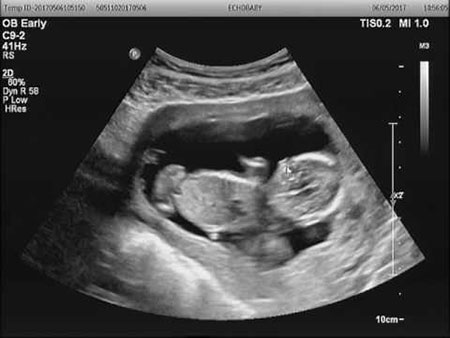
- At fourteen weeks, an ultrasound can assess the degree of development of the baby's brain, the formation of the spine, the symmetry of the fetal arms and legs, and even count the fingers and toes.
- An ultrasound can listen to the baby's heartbeat. The shorter the pregnancy, the faster the fetal heartbeat. After 14 weeks, the baby's heart rate will average 150 beats per minute.
- If the pregnancy is already 15 weeks old and the woman missed the first screening, then an ultrasound examination still needs to be done. During the procedure, the doctor will assess the overall development of the child, the correct location of the organs and rule out gross malformations.
Note!
An important criterion is the length of the baby's nasal bridge and the thickness of the nuchal space (TN). The TVP norm should not exceed 2.7 mm at this period. Values above this figure may indicate hereditary diseases of the fetus, Down syndrome, or the presence of an intrauterine infection in the fetus.
Is it possible to find out gender on an ultrasound?
You can find out the estimated sex of the baby already at the first ultrasound examination, in the period from 11 to 14 weeks. But the probability of a correct determination at this stage is about 60-70%, since the study may be hampered by the position of the child in the uterus or the umbilical cord located between its legs. Gender is determined much more accurately at 18-21 weeks of pregnancy.
On a note!
If you want to find out early on whether the baby will be a boy or a girl, this can be done using a paid DNA test (the genetic composition of the mother’s blood) after 8-10 weeks of pregnancy. It is necessary to donate blood from a vein to a laboratory to determine the sex of the child. Genetic blood testing is 99% accurate.
What does ultrasound diagnostics show?
If we take the first trimester of pregnancy, then almost every day there were some important changes, the formation of internal organs. At week 14 there are significantly fewer changes, because now the organs are already formed and continue to improve. Let's consider what is assessed during an ultrasound scan at this stage:
- child activity;
- place of attachment of the fetus in the uterus;
- baby’s movements, flexion and extension of limbs;
- proportionality of the head relative to the body;
- baby's facial expressions;
- the presence of a sucking reflex, the baby takes a finger in its mouth.
You might be interested in: Cervical canal: what is it?
Some experts claim that at 14 weeks the baby is similar to the facial features of mom or dad, but this issue is considered controversial.
The doctor can judge the harmonious development of the baby by certain parameters of the tiny organism. Here, the baby’s height, head circumference, chest circumference and some other data are taken into account.

Normal fetal parameters:
- The CTP (coccygeal-parietal size) should be about 75 mm at this time. KTR is the length from the crown to the tailbone. At earlier dates, this size could be used to determine the term with great certainty. Now this indicator is not so informative.
- BDP or biparietal size (transverse size of the child's head). It is this indicator that now allows us to judge the duration of pregnancy. Normally, the BPR should be about 27 mm.
- The abdominal roundness or roundness at week 14 is approximately 75-78 mm.
- The OG or roundness of the fetal head normally ranges from 95 to 97 mm.
- DB or length of the femur should be 12-12.5 mm.
- TVP or the thickness of the collar space (otherwise this indicator is called the cervical fold) is a marker with which it is possible to calculate the risk of having a baby with certain chromosomal diseases. With the normal development of pregnancy, TVP begins to gradually decrease at 14 weeks. If for the 13th week this figure ranged from 0.7 to 2.7 mm, then at the fourteenth week these figures should go down.
Ultrasound diagnostics makes it possible to detect abnormalities in the fetus in the early stages, in particular, to suspect diseases such as Down or Edwards syndrome. For this reason, a woman is strictly not recommended to skip the first screening.
What may concern you
| Increased blood pressure | On average, about 2% of all pregnancies are accompanied by hypertension. High blood pressure in the second trimester can negatively affect the baby's condition. Alarming signs are periodic headaches, tinnitus, nosebleeds and unpleasant pressing sensations in the heart area. If a pregnant woman has a tendency to have high blood pressure, you should definitely inform your doctor about this. |
| Phlebeurysm | During pregnancy, veins can be compressed by the growing uterus, which leads to impaired venous outflow. If there is a predisposition to varicose veins, pregnancy creates all the conditions for the development of the disease. As the period increases in weeks, the severity of the signs of this disease also increases. |
| Digestive problems | During the period of bearing a child, many pregnant women experience dyspepsia - functional digestive disorders. It is important in what trimester the problems in the gastrointestinal tract began. In the 2nd trimester, chronic diseases can worsen, and with poor nutrition, the digestive system becomes overloaded. In case of discomfort in the stomach and intestines, it is important to seek recommendations from a gastroenterologist. |
| Haemorrhoids | Constipation is a common problem in pregnant women, causing the appearance and development of hemorrhoids. Constipation can be caused by both an unbalanced diet and the hormone progesterone. It causes relaxation of vascular walls and ligaments, and reduces intestinal motility. Constipation, like hemorrhoids itself, cannot be ignored so as not to worsen your health. |
| Insomnia (sleep disorders) | Problems with falling asleep and uncomfortable sleep in pregnant women can be caused by many reasons: depression, stress, diseases of internal organs. The urge to go to the toilet at night and an enlarged belly, which does not allow you to take a comfortable position, also contribute to insomnia. How to help yourself? Remember the simple tips about your daily routine, ventilation, a warm bath and tea from “sleepy herbs” before bed. If insomnia persists, consult a psychologist to find the cause of your anxiety. |
| Decreased hemoglobin in the blood | The most active loss of iron begins just after the 14th week, which coincides with the period when the process of hematopoiesis begins in the fetus. If a woman's iron stores are depleted, she develops iron deficiency anemia of pregnancy. The normal hemoglobin content in the 2nd trimester is 112-130 g/l. Expectant mothers with mild to moderate anemia are treated on an outpatient basis. |
Diagnostics

Modern medicine allows us to diagnose most diseases at an early stage. List of mandatory tests at 14 weeks of pregnancy:
- general and detailed blood test;
- general urine analysis;
- smear of vaginal microflora;
- Ultrasound of the abdominal cavity;
- Ultrasound of the kidneys;
- Ultrasound of the bladder.
If necessary, the patient is referred for consultation to highly specialized doctors (gastroenterologist, nephrologist, etc.)
A detailed blood test gives a general idea of the state of a woman’s body. It is used to diagnose anemia, neoplasms, leukocytosis, infectious and inflammatory processes. A study of urine analysis and ultrasound results of the excretory system helps to identify the early stage of pyelonephritis, cystitis, and prevent the formation of kidney stones and kidney failure during childbirth.
Pregnant woman's diet
In the fourteenth week, it is important to enrich the pregnant woman’s menu with all useful biologically active substances. This is easy to do: you need to include seasonal fruits and vegetables in your diet of all colors: yellow, orange, green, purple and red. If one of the expectant mother’s unloved foods, for example, pumpkin, then it can be replaced with a vegetable or fruit of a similar color - carrots, yellow zucchini, apricots.

Pregnant women should avoid certain foods during this period, because... Due to the large amount of tyramine, they cause a narrowing of blood vessels, which is fraught with poor health and spontaneous headaches. Here is a short list of them:
- smoked/dried/marinated fish and meat;
- sausage, frankfurters, sausages;
- concentrated broths;
- kvass;
- pickled vegetables;
- Parmesan, cheddar, brie, Roquefort cheese;
- soy sauce, soy paste, soy curd.
Here's what a sample menu might look like at 14 weeks of pregnancy:
| Eating | Food and drink options |
| First breakfast | Oatmeal with milk and banana, sandwich with butter and cheese (Gouda), cocoa or chicory |
| Lunch | Baked apple with honey and walnuts, a handful of dried apricots, tea with chamomile and lemon balm |
| Dinner | Meatball soup, croutons, baked chicken breast with tomatoes and cheese, milk jelly, apple or orange juice |
| Afternoon snack | 200 ml drinking yoghurt without additives, muesli bar |
| Dinner | Boiled rice, baked fish (trout), fresh vegetable salad with olive oil, a slice of rye bread, dried fruit compote |
| Before bedtime | Sesame crackers, a glass of kefir |
How to make food easier to digest:
- at night, eat food 2-2.5 hours before bedtime;
- avoid heavy meals before bed;
- eat heated food, which puts minimal strain on the digestive system;
- a pinch of saffron and turmeric in a dish makes it easier to digest any food;
- You should not combine freshly prepared food with leftovers from previous meals;
- It is not recommended to mix hot and very cold foods at the same time, as this stresses the digestive enzymes.
What about vitamins? In the 2nd trimester, the expectant mother's need for vitamins and microelements increases. At this stage of the baby’s development, the following are very important:
- magnesium - this element ensures the functioning of the placenta, improves the elasticity of muscle fibers and their contractility;
- Vitamin D is necessary for the formation of the fetal skeleton. With a deficiency of this vitamin, calcium is poorly absorbed and the development and strengthening of the baby’s skeletal system is hampered. According to statistics, more than 90% of residents of central Russia experience vitamin D deficiency;
- B vitamins – participate in the development and formation of the circulatory, nervous, and digestive systems. They also keep mom’s skin hydrated and prevent moisture loss. Doctors recommend taking vitamins from this group throughout pregnancy.
Whether to choose a vitamin complex, a single drug in a prophylactic dosage, or adjust the menu - the doctor should make the choice, because a lot depends on the condition of the expectant mother.
Physical activity in the second trimester
Walking is the most optimal type of physical activity for pregnant women in the second trimester. But even just walking through the park, the expectant mother needs to take into account some features of both the walk and her position.

| How long to walk? | It is advisable for a mother expecting a baby to take a walk every day, spending a total of 1.5-2 hours a day in the fresh air. If for some reason a long walk is not possible, then you can go outside a couple of times a day, spending 30-40 minutes walking. Many expectant mothers continue to work and do not have the opportunity to go out on weekdays. In this case, it is advisable to get to/from work on foot at least once a day, and on weekends, plan a full-fledged walk in the park. |
| When to go for a walk? | It is very important to take into account your own biorhythms - some people like to walk more in the morning, while others are looking forward to an evening walk. If we are talking about the warm season, then it is advisable to spend time outside before 11 o’clock in the afternoon and after 17 o’clock in the evening, avoiding the peak of solar activity. During the most sunny hours, it is better for a pregnant woman to stay at home. Also, temperatures above 30 degrees are not suitable for walking - the risk of overheating is too high. In cold weather, you can walk provided there is no strong wind or precipitation. A comfortable temperature outside means we try to stay outside as much as possible. |
| Where to go for a walk? | Forested areas, squares and areas near water bodies are beautiful and picturesque places where a pregnant woman’s mood improves, a surge of strength appears and stress is relieved. All this has a beneficial effect on the well-being of the expectant mother. It is worth planning a specific route for yourself in advance. It’s great if there are benches nearby, so the expectant mother can sit down and relax if she feels tired. |
Important!
If a pregnant woman feels unwell, has shortness of breath or dizziness, then the walk must be stopped. This situation may arise if a pregnant woman previously led a sedentary lifestyle and her body has not yet adapted to loads of this kind. Go home and definitely see a doctor.
Vacation ideas

Lack of rest and proper sleep affects not only the well-being of the expectant mother, but also affects the growing body of the fetus. Even normal daytime fatigue is enough to cause changes in the fetal heart rate. How to cope with stress and normalize sleep? Here are some simple tips.
- A set of gentle physical exercises for pregnant women will help keep your figure in shape, and at the same time become a kind of release for accumulated tension in the muscles. If there are no health contraindications, then walking, water aerobics, and fitness for expectant mothers would be an excellent solution.
- Try to avoid stress and overwork. Fatigue accumulated during the day does not always lead to sound sleep. After a hard day, it is very difficult to relax while in a position. In the evening, you need to put off things that require intellectual and physical effort. And, of course, you should not watch action films, thrillers or horror films at night.
- When overstrained, relaxing water treatments are effective. For example, an enveloping warm bath with the addition of flavored sea salt and essential oils will be an excellent aid to sound and healthy sleep.
- Also, the expectant mother can ask someone close to her to give her a relaxing massage. This procedure will relieve back and lower back pain. Massaging your feet and ankles will help prevent cramps.
- To rest and relax a pregnant woman, it is recommended to focus on her breathing and take slow, deep breaths. Many people are helped by peaceful music or sounds of nature - the sound of the forest, surf, sea or rain.
- Before going to bed, it is advisable to drink a glass of warm milk (with cinnamon and honey) or herbal tea (chamomile, lemon balm, thyme, mint), which have a relaxing and sedative effect.
